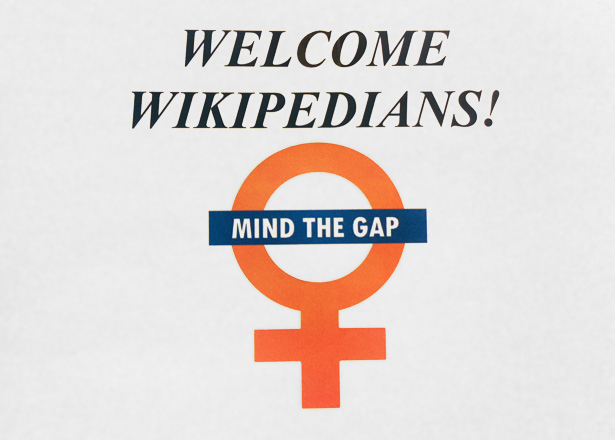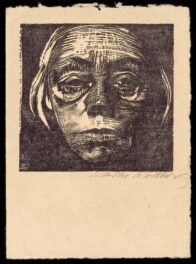
Welcome sign at Saturday’s Wikipedia edit-a-thon at the Wikimedia Foundation offices in San Francisco.
What’s the top hit when you google Louise Nevelson, Dorothea Lange, or Betye Saar? Wikipedia, of course. The online encyclopedia anyone can edit, Wikipedia features 22 million articles edited by 1 million+ volunteer editors in 285 languages.
Of those editors, however, only 9% are women—a fact that affects what gets written about and how. “People write about what they find interesting,” a longtime Wikipedian told me last Saturday at a Wikipedia edit-a-thon focused on boosting coverage of women. “And who people are affects what they find interesting.”
Edit-a-thon organizer Sarah Stierch, a Wikimedia Foundation fellow who just concluded a stint as Wikipedian-in-Residence at the Smithsonian, told me that only one in five biographies on Wikipedia cover women. And articles on women, including women artists, tend to be shorter than comparable ones on men.
By way of example, Mary Corse and Helen Pashgian, two of the women artists featured in Pacific Standard Time, have no entry. They’re “redlinks,” meaning they’re referenced in other articles but don’t have their own page. Riko Mizuno: redlink. Gertrud Natzler: redlink. (Here’s Otto Natzler’s page.)
At the edit-a-thon, I turned a redlink into a stub by starting an entry on Esther Baum Born, a Bay Area architectural photographer whose work is represented in the Research Institute’s special collections, as well as at UC Berkeley and the University of Arizona. Since then, three other editors have expanded and improved on it. (Thanks to a librarian colleague at the GRI for tipping me about Born!)
Women aren’t the only ones underrepresented on Wikipedia, for a variety of demographic reasons. The typical Wikipedian tends toward math, science, and pop culture, not art and the humanities. But we art geeks are out there, and yes, we like to edit!
If you want to turn a redlink into a stub, or a stub into an article, more communal editing will take place this weekend at Wiknics around the world. The L.A. meet-up is happening in Pan Pacific Park, so you can participate in the biggest and most democratic knowledge project the world has ever seen while scarfing a hot dog.




So true. I started one on women artists back in 2005 and wrote some on Catherina Hemessen and a few others. My women artist one was of course something from work that I had hoped the Internet hive mind would amend. I was just last night reading the comments for women artists. Other than slamming the writing and complaining, there weren’t major positive changes in the article since 2006. I was kinda stunned.
I do think it is about who is doing the writing. I was thinking about asking my interns to add articles from their research this summer just in a small effort to help the situation.
Hi Artlust, thanks so much for sharing your experience. That is very disspiriting, but good for you for contributing! The new drive to diversify Wikipedia editors (including geographically) will hopefully attract more women and members of other under-Wikified groups.
Love the idea to have interns contribute their research. People write about what interests them, but they also write about what they know–and who better to contribute than someone who has spent the summer immersed in a topic? At the edit-a-thon there was a student from UC Berkeley who told me about some experiments on campus to have students contribute articles on Wikipedia in lieu of more traditional assignments. He said there was some skepticism at first, but very quickly the students grew enthusiastic about being able to make a contribution that would last well beyond their semester.
Australian readers might be interested to contribute to this timeline on feminist art in Australia: http://en.wikipedia.org/wiki/Australian_feminist_art_timeline
Great list, thanks for the tip! The Timeline of Feminist Art on Wikipedia concentrates on U.S. art, but isn’t marked as such 🙂
http://en.wikipedia.org/wiki/Feminist_art#Timeline_of_Feminist_Art
Wikipedia has its own culture and rules. I would like to recommend “How Wikipedia Works” by Phoebe Ayers, Charles Matthews, and Ben Yates, if you would like to have a well-curated introduction.